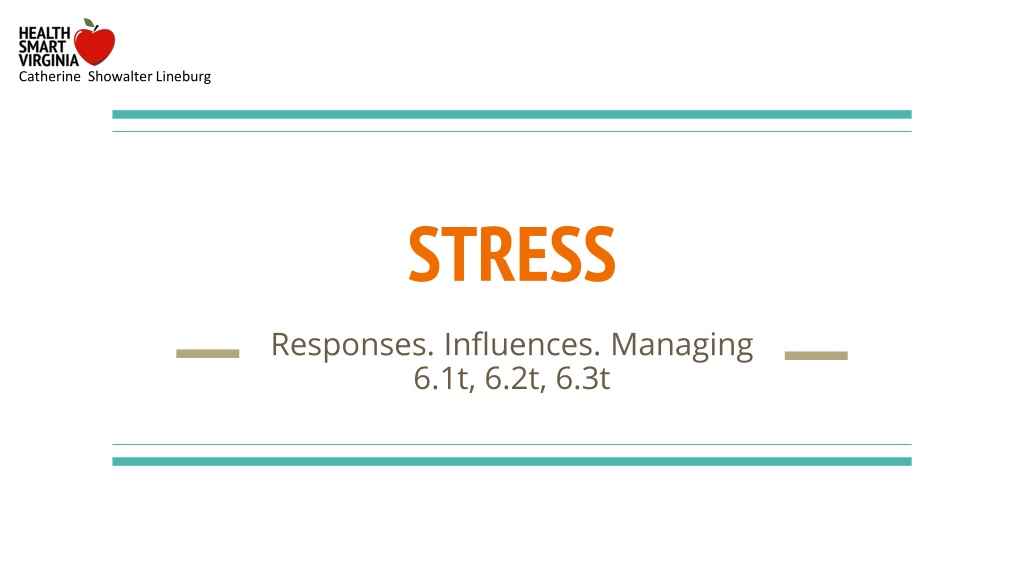Stress Management Strategies for Emotional and Social Well-being
Explore strategies to identify, analyze, and manage stress responses, influences, and factors affecting emotional and social health. Learn about positive and negative stressors, the STOP practice, yoga poses, and creating a stress management plan through mindfulness techniques.
Download Presentation

Please find below an Image/Link to download the presentation.
The content on the website is provided AS IS for your information and personal use only. It may not be sold, licensed, or shared on other websites without obtaining consent from the author. Download presentation by click this link. If you encounter any issues during the download, it is possible that the publisher has removed the file from their server.
E N D
Presentation Transcript
Catherine Showalter Lineburg STRESS Responses. Influences. Managing 6.1t, 6.2t, 6.3t
Please sit quietly Listen Close your eyes Peaceful music
How do you feel? Before coming in the classroom VS. How you feel after having a few quiet moments?
Learning Objectives I can identify potential positive and negative responses to stress and criticism (6.1t) I can analyze internal factors, such as responses to criticism or stress, which influence emotional and social health (6.2t) I can create a plan to manage stress (6.3t)
Introduction The Mason Jar What is the first thing that pops into your mind when you hear the word stress? In your own words, how would you define Stress? Key Terms Internal Stressors External Stressors Eustress (positive stress) Distress (negative Stress)
Stress Test Questions Add the numbers on the Stress Test Under 20 Low Stress, 21 to 30 Medium Stress, 31 and up High Stress
Why is identifying our stressors important? Do you think ALL stress is bad for you? Explain. Effects of Stress Worksheet
The Stop Practice Mindful Practice(s) The STOP acronym stands for: S: Stop. Whatever you re doing, just pause momentarily. T: Take a breath. Reconnect with your breath. The breath is an anchor to the present moment. O: Observe. Notice what is happening. What is happening inside you, and outside of you? Where has your mind gone? What do you feel? What are you doing? P: Proceed. Continue doing what you were doing. Or don t: Use the information gained during this check-in to change course. Whatever you do, do it mindfully.
Practice Yoga Poses Mindful Movement Activities Red Light, Yellow Light, Green Light YOGA Activity Heartbeat Exercise
Closure Revisit The Mindful Jar Revisit Questions posed throughout the lesson. Create a Plan to Manage Stress What is mindfulness? The practice of of paying attention of noting whatever is happening in the moment with a gentle and open mind. Healthy Coping Worksheet
Extensions/Connections/Applications Extensions/Connections/Applications Draw a picture & Mindful practice Watch and stop the video to participate. Mindful Exercise: Still, Quiet Place Stop the video and have students in class to draw their happy place (just like the character in the video). (5-10 minutes) * Draw with computers or on paper. Restart the video. Stop video when and close your eyes and picture yourself in your happy place. (3- 5 minutes) Finish watching the video. How did you feel picturing yourself in this happy place? Was it difficult to quiet your thoughts? Remind students that it takes consistent practice to be able to focus and still their minds. Stress Buster Bingo Heartbeat Exercise
Resources Resources/References Lesson activities are credits to the awesome resource links below that have been borrowed and copied to ensure the lesson supports student learning. Health Smart Kids Health What is mindfulness? Mindfulness Activities Mindfulness STOP SKill STRESSED OUT! Youth Smart Stress Workbook Yoga Games Red Light, Green Light Yoga Yoga Journal























